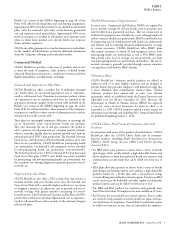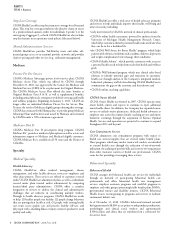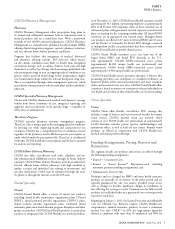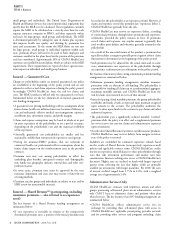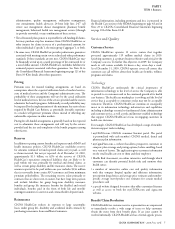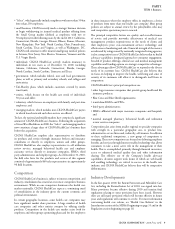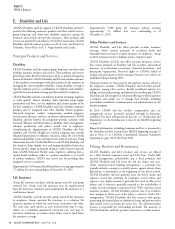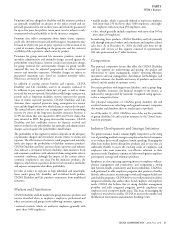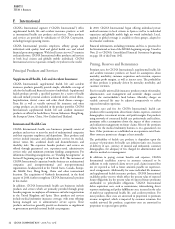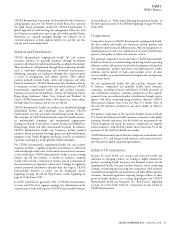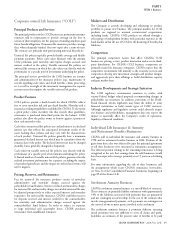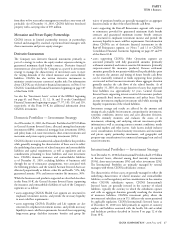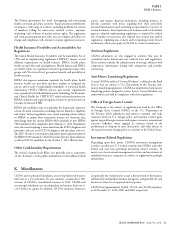Cigna 2010 Annual Report Download - page 31
Download and view the complete annual report
Please find page 31 of the 2010 Cigna annual report below. You can navigate through the pages in the report by either clicking on the pages listed below, or by using the keyword search tool below to find specific information within the annual report.CIGNA CORPORATION 2010 Form 10K 11
PARTI
ITEM 1 Business
Premiums and fees charged for disability and life insurance products
are generally established in advance of the policy period and are
generally guaranteed for one to three years and selectively guaranteed
for up to fi ve years, but policies can in most cases be subject to early
termination by the policyholder or by the insurance company.
Premium rates refl ect assumptions about future claims, expenses,
credit risk, investment returns and profi t margins. Assumptions may
be based in whole or in part on prior experience of the account or on
a pool of accounts, depending on the group size and the statistical
credibility of the experience, which varies by product.
Premiums for group universal life insurance products consist of
mortality, administrative and surrender charges assessed against the
policyholder’s fund balance. Interest credited and mortality charges
for group universal life, and mortality charges on group variable
universal life, may be adjusted prospectively to refl ect expected
interest and mortality experience. Mortality charges are subject to
guaranteed maximum rates, based on standard mortality tables,
which rates are stated in the policy.
In addition to paying current benefi ts and expenses, CIGNA
Disability and Life establishes reserves in amounts estimated to
be suffi cient to pay reported claims not yet paid, as well as claims
incurred but not yet reported. For liabilities with longer-term pay-out
periods such as long-term disability, reserves represent the present
value of future expected payments. CIGNA Disability and Life
discounts these expected payments using assumptions for interest
rates and the length of time over which claims are expected to be paid.
e annual eff ective interest rate assumptions used in determining
reserves for most of the long-term disability insurance business is
4.75% for claims that were incurred in 2010 and 5% for claims that
were incurred in 2009. For group universal life insurance, CIGNA
Disability and Life establishes reserves for deposits received and
interest credited to the policyholder, less mortality and administrative
charges assessed against the policyholder’s fund balance.
e profi tability of this segment’s products depends on the adequacy
of premiums charged and investment returns relative to claims and
expenses. e eff ectiveness of return to work programs and mortality
levels also impact the profi tability of disability insurance products.
CIGNA Disability and Life’s previous claim experience and industry
data indicate a correlation between disability claim incidence levels
and economic conditions, with submitted claims rising under adverse
economic conditions, although the impact of the current adverse
economic conditions is not clear. For life insurance products, the
degree to which future experience deviates from mortality, morbidity
and expense assumptions also aff ects profi tability.
In order to reduce its exposure to large individual and catastrophic
losses under group life, disability and accidental death policies,
CIGNA Disability and Life purchases reinsurance from unaffi liated
reinsurers.
Markets and Distribution
CIGNA Disability and Life markets the group insurance products and
services described above to employers, employees, professional and
other associations and groups in the following customer segments:
•national accounts, which are multi-site employers generally with
more than 5,000 employees;
•middle market, which is generally defi ned as multi-site employers
with more than 250 but fewer than 5,000 employees, and single-
site employers with more than 250 employees; and
•select, which generally includes employers with more than 50 but
fewer than 250 employees.
In marketing these products, CIGNA Disability and Life primarily
sells through insurance brokers and consultants and employs a direct
sales force. As of December 31, 2010, the fi eld sales force for the
products and services of this segment consisted of approximately
200 sales professionals in 27 offi ce locations.
Competition
e principal competitive factors that aff ect the CIGNA Disability
and Life segment are underwriting and pricing, the quality and
eff ectiveness of claims management, relative operating effi ciency,
investment and risk management, distribution methodologies and
producer relations, the breadth and variety of products and services
off ered, and the quality of customer service.
For certain products with longer-term liabilities, such as group long-
term disability insurance, the fi nancial strength of the insurer, as
indicated by ratings issued by nationally recognized rating agencies,
is also a competitive factor.
e principal competitors of CIGNA’s group disability, life and
accident businesses are other large and regional insurance companies
that market and distribute these or similar types of products.
As of December 31, 2010, CIGNA is one of the top fi ve providers
of group disability, life and accident insurance in the United States,
based on premiums.
Industry Developments and Strategic Initiatives
e group insurance market remains highly competitive as the rising
cost of providing medical coverage to employees has forced companies
to re-evaluate their overall employee benefi t spending. Demographic
shifts have further driven demand for products and services that are
suffi ciently fl exible to meet the evolving needs of employers and
employees who want innovative, cost-eff ective solutions to their
insurance needs. Employers continue to shift towards greater employee
participatory coverage and voluntary purchases.
Employers are also expressing a growing interest in employee wellness,
absence management and productivity and recognizing a strong
link between health, productivity and their profi tability. CIGNA is
well-positioned to off er employers programs that promote a healthy
lifestyle, off er assistance in returning to work and integrate health care
and disability programs. CIGNA believes it is well positioned to deliver
integrated solutions that address these broad employer and employee
needs. CIGNA also believes that its strong disability management
portfolio and fully integrated programs provide employers and
employees tools to improve health status. is focus on managing the
employee’s total absence enables CIGNA to increase the number and
likelihood of interventions and minimize disabling events.




